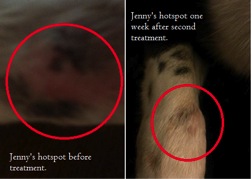Laurie's Blogs.
Jun 2015
A Case Study about a Nagging Hot Spot... that REHAB cured!!!
(Article written by Monika Hoyer)
Jenny is a five-year-old Australian Cattle Dog cross that actively competes in Agility. Last summer (2014) I had Jenny coned almost all summer trying to heal a very bad hot spot on her leg. She was either wearing a cone or had her leg wrapped. No matter what I did the spot kept getting worse as she would attack her leg at any given chance. I also took her to the vet several times with no luck (the suggested treatments did not help). It was very stressful for me. After four months of no success I finally took her to the Canine Fitness Centre (CFC). It turns out her neck and front ribs were out of alignment. Two treatments ([manual therapy] and laser) and one week later this is how good her leg looked. Of note, she wasn't coned either, it actually healed that fast once correctly treated. So happy I took her to CFC.
- Brenda O.

Jenny’s story is not unusual. It is estimated that approximately 60% of lick granulomas caused by excessive licking are due to nerve irritation and not to allergic reactions, psychological problems, or external skin irritations, as often suggested to owners following veterinary examinations.
Cones, wraps, and constant distractions in the form of toys or bones may prevent the dog from licking but do not solve the underlying problem: irritation of the nerves caused by a musculoskeletal issue causing pain, tingling, or other sensation in the affected area.
Jenny had a licking problem. Lots of the dogs we see at the CFC come to us with a licking problem and sometimes we discover a licking problem while seeing the dog for other more obvious symptoms.
In many cases lick dermatitis in dogs is mistakenly attributed to allergies, skin conditions, or psychological distress such as anxiety or boredom, but some bodies of research suggest that approximately 60% of granulomas caused by excessive licking may in fact be due to nerve irritation.
In 1995 a study was being conducted on the use of antidepressants to treat lick dermatitis in a small group of dogs. The primary purpose of the study was to investigate the effect that a psychiatric drug could have on what is often considered to be a psychological condition. During screening of their study group the researchers discovered something interesting: 56% of their study group showed
EMG abnormalities when tested. EMG tests for the health of muscles and the nerves that control them. The dogs in question showed abnormal electrical discharges in the muscles activated by the same nerves that supply sensation to the areas the dogs were licking.
These results revealed that the problem might not be behavioural at all, but rather a physical condition that is treatable either by surgery, or in the case of our clinic, conservative management using manual therapies and other modalities. So, the next time you see a dog with a licking problem give us a call, it might not be just in their head!
Reference: Steiss, J.E., Bradley, D.M., MacDonald B.J., et al. Letter to the editor in Veterinary Dermatology, Vol. 6, No. 2, pp.115-116, 1995.


